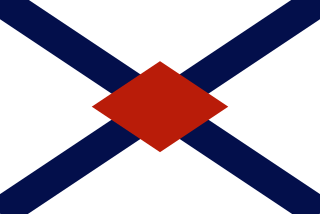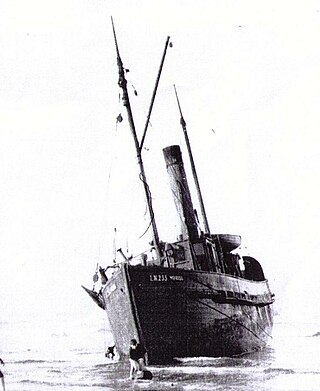Related Research Articles

Fiji, officially the Republic of Fiji, is an island country in Melanesia, part of Oceania in the South Pacific Ocean. It lies about 1,100 nautical miles north-northeast of New Zealand. Fiji consists of an archipelago of more than 330 islands—of which about 110 are permanently inhabited—and more than 500 islets, amounting to a total land area of about 18,300 square kilometres (7,100 sq mi). The most outlying island group is Ono-i-Lau. About 87% of the total population of 924,610 live on the two major islands, Viti Levu and Vanua Levu. About three-quarters of Fijians live on Viti Levu's coasts: either in the capital city of Suva; or in smaller urban centres such as Nadi—where tourism is the major local industry; or in Lautoka, where the sugar-cane industry is dominant. The interior of Viti Levu is sparsely inhabited because of its terrain.

The Syria was a 1,010 ton, iron sailing ship with a length of 207.7 feet, breadth of 34.1 feet and depth of 20.8 feet. She was built by William Pile of Sunderland for the Nourse Line, named after the Syria River in Karnataka, India and launched in 1868. She was primarily used for the transportation of Indian indentured labourers to the colonies.
The Berar, named after a region in western India, was a sailing ship of 902 tons, owned by Tyser & Haviside and was built in 1863 by William Pile at Sunderland.
The Poonah, named after the city of Poonah in western India, was a three masted sailing ship of 1199 tons, owned by Tyser & Haviside and was built in 1867 by William Pile at Sunderland.
Newnham was the first steamship to bring Indian indentured labourers to Fiji, arriving at Suva on 23 July 1884 carrying 575 passengers. The 1296 ton steamer took only 38 days to reach Fiji as it was able to take the shorter route through the Timor sea.
Pericles, named after the Athenian leader Pericles, was a 1,598 ton, iron hulled, three masted sailing ship, that was built by W. Hood & Co of Aberdeen, and launched in July 1877 to transport wool for the Aberdeen Line.
Boyne was a 1,403 ton, Nourse Line sailing ship that T.R. Oswald of Southampton built in 1877. She was referred to as the "Hoodoo Ship" for the number of mishaps that occurred to her. She wrecked in 1886.
Hereford was a 1456-ton iron sailing ship with two decks and one cemented bulkhead which was built in 1869 by J. Elder & Company at Glasgow for the Merchant Shipping Company of London. She was chartered by the New Zealand Shipping Company in the 1870s and made three voyages to Lyttelton, New Zealand with approximately three hundred emigrants each time. The first voyage in 1874 took 87 days, and the second took 80 days, arriving in Lyttelton on 19 January 1878. In 1881, she was stranded on Ingleby Reef near Port Phillip Heads, Melbourne, Victoria, Australia, and towed off on 12 March 1881 by a tug.

The Nourse Line was a shipping company formed by Captain James Nourse in 1861. After taking delivery of his first ship, the Ganges, in 1861, Nourse went on to build up one of the last great fleets of sailing ships.
The Indian indenture system was a system of indentured servitude, by which more than one million Indians were transported to labour in European colonies, as a substitute for slave labor, following the abolition of the trade in the early 19th century. The system expanded after the abolition of slavery in the British Empire in 1833, in the French colonies in 1848, and in the Dutch Empire in 1863. British Indian indentureship lasted till the 1920s. This resulted in the development of a large Indian diaspora in the Caribbean, Natal, East Africa, Réunion, Mauritius, Sri Lanka, Malaysia, Myanmar, British Guyana, to Fiji, as well as the growth of Indo-Caribbean, Indo-African, Indo-Fijian, Indo-Malaysian, Indo-Guyanese and Indo-Singaporean populations.
Yanuca Lailai is a 72-acre (0.29 km2), volcanic rock, limestone island located between the islands of Ovalau and Moturiki in Fiji. The coastline has mangrove trees, volcanic rock cliffs and beaches, and the interior abounds in jungle.
Indo-Fijians or Indian-Fijians are Fijian citizens of Indian descent, and include people who trace their ancestry to various regions of the Indian subcontinent. Although Indo-Fijians constituted a majority of Fiji's population from 1956 through the late 1980s, discrimination and the resulting brain drain resulted in them numbering 313,798 (37.6%) out of a total of 827,900 people living in Fiji as of 2007.

Muriel was a New Zealand fishing trawler that was built in 1907 by Messrs Lane & Sons of Totara North. In 1937, Muriel stranded on Sumner Bar at Christchurch, New Zealand, and was a total loss.
Between 1879 and 1916, tens of thousands of Indians moved to Fiji to work as indentured labourers, especially on sugarcane plantations. Repatriation of indentured Indians from Fiji began on 3 May 1892, when the British Peer brought 464 repatriated Indians to Calcutta. Various ships made similar journeys to Calcutta and Madras, concluding with Sirsa's 1951 voyage. In 1955 and 1956, three ships brought Indian labourers from Fiji to Sydney, from where the labourers flew to Bombay.
Indo–Saint Lucians or Indian–Saint Lucians, are Saint Lucians whose ancestry lies within the country of India, primarily the modern-day Indian states of Bihar, Jharkhand and Uttar Pradesh in Northern India. In 1859, the British began transporting indentured workers from British India to work on plantation estates in Saint Lucia, which had become a British colony in 1814. The first ship carrying 318 indentured workers from India, the Palmyra, arrived in Saint Lucia on 6 May 1859, and the last ship carrying Indian indentured workers, the Volga, arrived on 10 December 1893.

The SS Taiaroa was 228 ton Union Steam ship coaster that grounded near the Waiau Toa / Clarence River on 11 April 1886. Thirty six people, 15 passengers and 21 crew, total lost their lives when they abandoned the boat after it had grounded.
The Indian community in Saint Kitts and Nevis is made up of Indo-Kittitians, Indo-Nevisians, non-resident Indians and persons of Indian origin. Indo-Kittitians and Indo-Nevisians are nationals of Saint Kitts and Nevis whose ancestry lies within the country of India. The community originated from the Indian indentured workers brought to Saint Kitts and Nevis by the British in 1861 and 1874 respectively. By 1884, most of the community had emigrated to Caribbean nations with larger Indian populations such as Trinidad and Tobago, Guyana and Suriname.

The majority of Fiji's islands were formed through volcanic activity starting around 150 million years ago. Today, some geothermic activity still occurs on the is lands of Vanua Levu and Taveuni. Fiji was settled first by the Lapita culture, around 1,500–1,000 years BCE, followed by a large influx of people with predominantly Melanesian genetics about the time of the beginning of the Common Era. Europeans visited Fiji from the 17th century, and, after a brief period as an independent kingdom, the British established the Colony of Fiji in 1874. Fiji was a Crown colony until 1970, when it gained independence as the Dominion of Fiji. A republic was declared in 1987, following a series of coups d'état.

PS Governor Wynyard, was a small steam ship, the first to be built in New Zealand, and was launched in 1851. She was a paddle steamer schooner, built of pohutukawa, with kauri planks. In 1853 she left her Tamaki River service in Auckland and was sold in Melbourne in 1852 during the gold rush, but was soon serving as a ferry in Tasmania, until she had her primitive engines removed in 1858. She sprang a leak and became a beached wreck in 1873.
References
- ↑ "Historical Timeline". Archived from the original on 13 September 2009.
- ↑ Daily Southern Cross, Port of Melbourne, 8 September 1866 http://paperspast.natlib.govt.nz/cgi-bin/paperspast?a=d&d=DSC18660908.2.5.1
- ↑ Daily Southern Cross, Bay of Islands Shipping, 5 December 1870, http://paperspast.natlib.govt.nz/cgi-bin/paperspast?a=d&d=DSC18701205.2.4.4